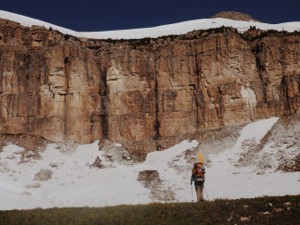We have stopped for the day after a short hike to take a half day to recover from our arduous trek across the top of the Chinese Wall.
We are camped on the banks of the West Fork of the South Fork of the Sun River in a shady grove of lodgepole pines. We have a nice beach, good sitting logs, a stone firepit, a bear pole, and green luxurious grass for lounging. I am drinking coffee and the boys are playing a game of hearts.
We have looked forward to being off of our feet for a few hours to rest them. The dogs are weary!
As we reflect on the past few days and the expedition leadership curriculum that we teach at MOHAB, we have learned an invaluable decision-making process.
We evaluate risk at every opportunity. Decision-making is based on a framework created by a matrix where one axis is the probability that an event will occur (e.g., flipping a packraft in a rapid or falling on a steep slope) and the other axis is the probability of a consequence resulting from that event (e.g., a dangerous swim in the case of a flipped boat, or a broken bone in the case of a hiking fall). Each cell of the matrix is the decision we make. If the probability of the event is low and the probability of the consequence is low, then our decision is usually “Go!” If the probability of both the event and the consequence are high, then our decision is usually “Stop!” Combinations of low probability of the event combined with high probability of the consequence are the scariest combinations. This is what we faced yesterday when making the decision on whether to take the mountaineer’s route (low probability of a fall, but with really bad consequences if it happened) or a longer, alternative route (with a high probability of exhaustion and night hiking but low probability of bad consequences). We take a conservative approach and don’t want to be put in a position where we have to manage a bad consequence.
A strong tolerance for uncertainty is critical in wilderness expedition travel, and we have had our fair share. High water levels, logjams, bushwhacking, routes not going how we expect, heat, not knowing if or what creeks are flowing, weather … The list is long.
This uncertainty causes what we call “expedition stress” – the combination of physical, mental, and emotional states that respond to uncertainty and adversity. Every one of us has undergone “expedition stress” at various levels at various times. Learning how to manage it and how to respond to others going through it is one of the most valuable experiences for youth to learn. It’s a beautiful thing to watch people face their trials and come out the other side, and even better to see that an internal transformation has occurred as a result of the process.
Being able to make decisions where you understand the probability of events and consequences, and being able to manage stress by increasing your tolerance for uncertainty and adversity – these are the hallmark skills learned in the context of a long and difficult expedition. These are the lessons I hope our Crew members will learn, so they can take them into adulthood and be productive citizens – employees and employers, fathers, and husbands.
We have blown up our packrafts and are ready to paddle tomorrow. We hope to complete the West Fork tomorrow and camp somewhere on the South Fork of the Sun tomorrow night.
Photo:
Walker under the upper cliffs of the Chinese Wall on the bench near Sphinx Mountain, yesterday.
Godspeed – RJ
Enjoy live dispatches and photos via satellite from this expedition online at http://www.ryanjordan.com/ and receive updates from Twitter via @bigskyry (http://www.twitter.com/bigskyry).
